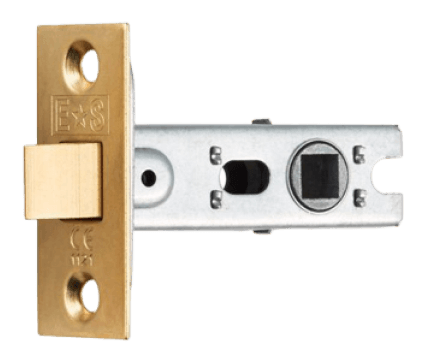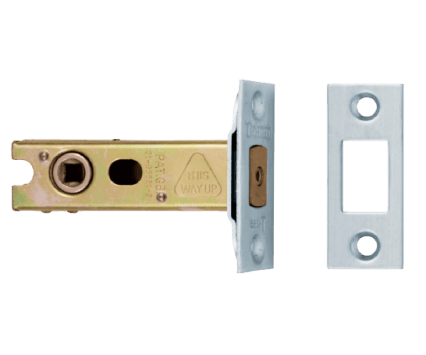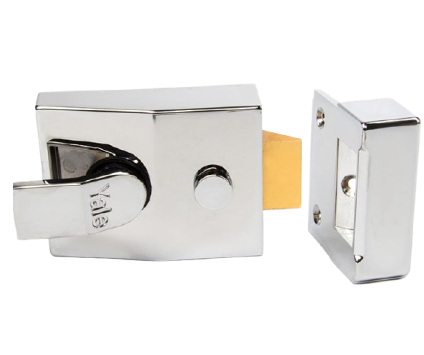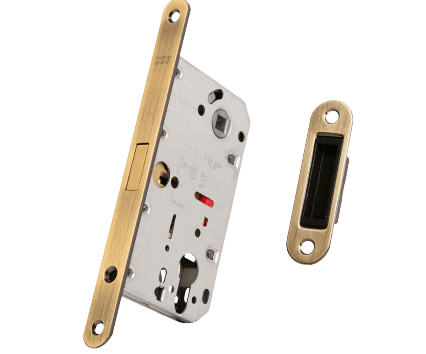Home Security Guides
A Guide to Locks
Keep homes, offices and storage well protected with our guide to locks and security. This guide will help you make the right choices in creating a safe and secure environment.

Contents
Intro
Door locks are an essential part of providing safety, security and privacy in any establishment whether at home or in the workplace. To make your space as secure as possible, it is important to know the main differences between lock types and their application.
Comparing Lock Types
| Lock Type | Security Rating | Best Used For | Features |
|---|---|---|---|
| Padlock | ✪ to ✪ ✪ ✪ ✪ | Drawers, cupboards, gates, vans, sheds, lockers, toolboxes, chains | Wide range of applications, easy to use, lots of choice, surface mounted |
| Door Latch | ✪ | Internal doors | Cost effective, easy to install, not lockable |
| Bathroom lock | ✪ | Bathroom doors | Safe, matches other doors, more expensive than a sliding bolt |
| Deadbolt | ✪ | Commercial bathroom doors | Safe, high traffic application, easy to install, easy retro fit, more expensive than sliding bolt |
| Nightlatch | ✪ ✪ | Front door | Easy access, less secure |
| Rim lock | ✪ ✪ | External doors | Cost effective, easy to install, less secure |
| 3 Lever Lock (Sashlock & Deadlock) | ✪ ✪ ✪ | Internal doors | Cost effective, Keyed only, less secure |
| Euro cylinder lock (3-pin) | ✪ ✪ ✪ | Internal doors on rental properties | Thumbturn on one side, optional key on other side, less secure |
| 5 Lever Lock (Sashlock & Deadlock) | ✪ ✪ ✪ ✪ ✪ | External doors | High security, insurance approved, key only |
| Euro cylinder lock (5-pin) | ✪ ✪ ✪ ✪ ✪ | External doors | High security, thumbturn on one side, optional key on other side |
| Night latch (Kitemarked) | ✪ ✪ ✪ ✪ ✪ | Front door | High security, easy access |
Mortice Locks
A mortice lock is “morticed” or installed into a cavity within the door frame. Mortice locks are strong and perfect to use on external doors. However, they can also be used on internal doors and are commonly used as bathroom door locks.
5 lever mortice locks provide extra security and importantly meet the lock standards set by some insurance companies. These locks operate a series of 5 levers when opening and closing the bolt making them the ideal choice for extra peace of mind.
Mortice locks are generally split into 2 standard sizes, 76mm (3’’) and 64mm (2.5’’). We would recommend 76mm for fire rated doors and 64mm for glazed doors. There are also horizontal locks that range between 125mm and 150mm, though these are less common on modern installations.
Important note. If you are replacing a mortice lock, measure from the edge of the door to the centre of the handle. If the measurement is close to 55mm you require a 76mm lock, closer to 45mm you require a 64mm lock.
The more specific name for this type of latch is Tubular mortice latch. When purchasing door handles in combination with the door latch, the provided spindle (square through bar) is a standard size that all latches will match. A Tubular mortice latch is used for internal doors where no lock is required.

Type: Sashlock
- Security Rating: 3 Lever ✪ ✪ ✪, 5 Lever ✪ ✪ ✪ ✪ ✪
- Best Use: 3 Lever - Internal doors, 5 Lever - External doors
A mortice sashlock is a lock that operates with a key and a handle/knob. A sashlock can be left locked or unlocked. When unlocked the door can be opened solely by turning the handle/knob. A 3 lever mortice sashlock would be used on an internal door and a 5 lever on an external door (normally the back door).

Type: Deadlock
- Security Rating: 3 Lever ✪ ✪ ✪, 5 Lever ✪ ✪ ✪ ✪ ✪
- Best Use: 3 Lever - Internal doors, 5 Lever - External doors
A mortice deadlock is more commonly referred to as a deadlock. These locks operate solely via a keyhole on both sides of the door. They are commonly found on front doors for security and insurance purposes. Deadlocks are often coupled with a nightlatch (see below) for added security. Internal 3 lever versions also exist for niche purposes.

Type: Bathroom Locks
- Security Rating: ✪
- Best Use: Bathroom doors
A mortice bathroom lock will look almost identical to a sashlock. However they have 2 spindle slots, rather than 1 slot and a keyhole. The second, smaller, spindle slot is a universal size for any bathroom thumbturn and release. A bathroom lock allows for the installation of a “bathroom turn and release”. These allow the door to be accessed from the outside in case of emergency.

Type: Euro Cylinder Locks
- Security Rating: 3 Pin ✪ ✪ ✪, 5 Pin ✪ ✪ ✪ ✪ ✪
- Best Use: 3 Pin - Internal doors on rental properties, 5 Pin - External doors
A Euro cylinder lock is a mortice lock very similar to a sashlock. However, they come in 2 parts, a cylinder case and a Euro cylinder. The cylinder case is installed exactly like a sashlock/deadlock, but the Euro cylinder is slotted though the cross-section. The cases are split into the following types; Internal or External and Sashlock or Deadlock. The cylinders are also split by Internal or External. Internal can be as low as 3-pin while external is 5 and above.
Deadbolt locks are designed to operate without the need for a lever handle. The door is operated with a finger plate/pull handle system. Ideal for high traffic restrooms where wear and tear might become an issue. The deadbolt looks very similar to a door latch and the installation is simple.

Type: Rebated Locks
These are designed for use with French doors, where one door is locked onto the other. One of the doors will usually be fixed in place with bolts at the top and bottom. The 2nd door is then locked to it using a rebate kit as an attachment for standard 3 lever and 5 lever sashlocks or a lock that is built with a rebate (often a 2 lever 64mm sashlock).
Surface Locks
As the title suggests surface locks are those mounted on the surface of the door. These types of locks are used almost exclusively for external doors. Unless specified, they won’t be insurance approved without a high security counterpart (5 lever deadlock or similar). There are 2 common types of surface mounted locks.
A nightlatch commonly known as a Yale lock is designed to provide easy access to a property. They come in 2 sizes, the standard 60mm and the smaller 40mm.
There are different types of night latch including:
- Standard - when the door closes and is held in place by the bolt, the only way to open the door from the outside is with a key in the rim cylinder. It has a snib function to keep the nightlatch fixed in the open position to avoid being locked out. One of the most popular ranges of standard is the Yale night latch.
- Deadlocking – operates on the same mechanism as a standard night latch except it can be locked from the outside. When locked the night latch is completely inoperable until unlocked. While an effective anti-crime feature, there is a possibility of having an occupant locked within.
- Double locking – similar operating mechanism to a deadlocking nightlatch, but there is a keyhole on the inside to allow occupants to operate the lock from the inside. The ERA BS Kitemarked are one of a few nightlatches that are insurance approved for use without an additional high security lock.
- Rollerball – When the door is closed, it does not lock automatically. The user will have to operate the lever to lock the door. A rollerbolt nightlatch is therefore ideal to avoid accidental lock-outs.

Type: Rim Lock
- Security Rating: ✪ ✪
- Best Use: External Doors
Rim locks are predominantly used for sheds and gates. Rim automatic deadlocks are mounted on the surface inside, long keys are provided to go through the door. Because of the closed system, they can withstand the weather much more effectively than any other lock type.
Padlocks
Padlock is a portable lock that is not attached to a door. Fundamentally, there are two types of padlock; a keyed and a combination padlock. Padlocks generally have a shouldered shackle locking system for a variety of uses including sheds, bikes, toolboxes and locker. The quality and strength of a padlock can vary quite considerably and the surface it is being attached to can also affect the overall security.
Magnetic Locks
Magnetic door locks are a relatively new innovation that allows users quieter and more seamless door operation. Instead of the traditional latchbolt and deadbolt combination, which can be loud and clunky, maglocks work by combining these two functions into one modern, sleek solution. When the door is open, the deadbolt/latch is fully retracted, creating a flush finish. When the door is closed, the maglock is attracted to another magnet at the back of the striker's keep, thus acting as a latch. To lock the door, turn the key or thumb turn, and the magnet will be locked in place.
Lock Symbols and Logos

Certifire
A certification scheme which is run independently to ensure performance, quality and reliability with regards to fire safety.

Conformité Européenne
The baseline manufacture quality that meets EU requirements

British Standards
Includes base CE conformity and much stricter testing

Secured by Design
Includes base CE conformity and much stricter testing




